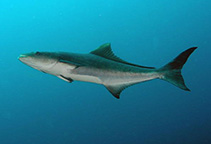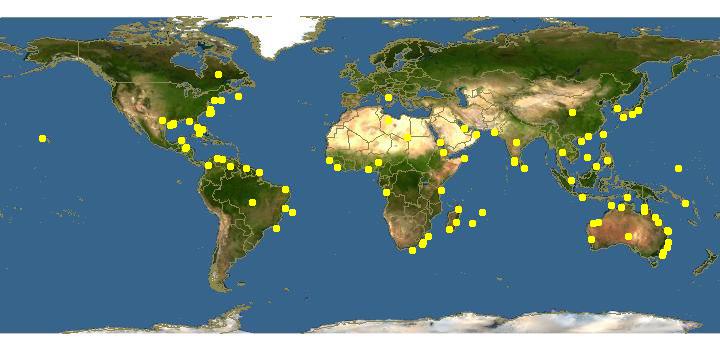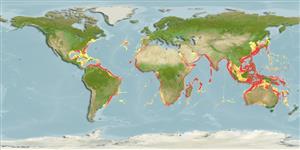http://www.fishbase.org/Summary/speciesSummary.php?genusname=Rachycentron&speciesname=canadum ---> http://192.134.151.83/Summary/speciesSummary.php?genusname=Rachycentron&speciesname=canadum
http://192.134.151.83/Summary/speciesSummary.php?genusname=Rachycentron&speciesname=canadum ---> https://fishbase.mnhn.fr/Summary/speciesSummary.php?genusname=Rachycentron&speciesname=canadum
https://fishbase.mnhn.fr/Summary/speciesSummary.php?genusname=Rachycentron&speciesname=canadum ---> https://fishbase.mnhn.fr/summary/Rachycentron-canadum.html
Rachycentron canadum, Cobia : fisheries, aquaculture, gamefish

You can
sponsor
this page
Common name (e.g. trout)
Genus + Species (e.g. Gadus morhua)
-

-
About this page
-
Languages
-
User feedbacks
-
Citation
-
Uploads
-
Related species
-


 Cobia
Add your observation in
Fish Watcher
Upload your
photos
and
videos
Cobia
Add your observation in
Fish Watcher
Upload your
photos
and
videos
Pictures
|
Videos |
Stamps, Coins Misc.
|
Google image
 Rachycentron canadum
Rachycentron canadum
Picture by
Cox, C.D.
Teleostei (teleosts) >
Carangiformes
(Jacks) >
Rachycentridae
(Cobia)
Etymology:
Rachycentron:
Greek, rhachis, -ios = spine + Greek, kentron = sting (Ref.
45335
)
.
More on author:
Linnaeus
.
Environment: milieu / climate zone / depth range / distribution range
Ecology
Marine; brackish; reef-associated; oceanodromous (Ref.
51243
); depth range 0 - 1200 m (Ref.
9739
). Subtropical; 17°C - 32°C (Ref.
12459
); 47°N - 37°S, 98°W - 166°E (Ref.
12459
)
Worldwide in tropical and subtropical waters, but absent in the eastern Pacific (Ref.
9739
,
33390
) and the Pacific Plate, except marginally (Ref.
10948
). Western Atlantic: Canada (Ref.
5951
) to Bermuda and Massachusetts, USA to Argentina (Ref.
7251
), including the Gulf of Mexico (Ref.
9626
) and entire Caribbean (Ref.
26938
). Eastern Atlantic: Morocco to South Africa. Indo-West Pacific: East Africa (Ref.
2871
,
5213
,
6644
,
30573
) and Hokkaido, Japan to Australia.
Length at first maturity / Size / Weight / Age
Maturity: L
m
?
, range 43 - ? cm
Max length : 200 cm TL male/unsexed; (Ref.
10790
); common length : 110 cm TL male/unsexed; (Ref.
3487
); max. published weight: 68.0 kg (Ref.
7251
); max. reported age: 15 years (Ref.
9739
)
Dorsal
spines
(total): 7 - 9;
Dorsal
soft rays
(total): 26-33;
Anal
spines
: 2-3;
Anal
soft rays
: 22 - 28. This species is distinguished by the following characters: head broad and depressed; first dorsal fin usually with VIII short but strong isolated spines, not connected by a membrane; caudal fin lunate to emarginate in adults, upper lobe longer than lower, rounded in young with prolonged central rays. Colour of back and sides dark brown, with 2 sharply defined narrow silvery bands, belly yellowish (Ref.
10948
,
90102
).
Adults occur in a variety of habitats, over mud, sand and gravel bottoms; over coral reefs, off rocky shores (Ref.
10948
) and in mangrove sloughs; inshore around pilings and buoys, and offshore around drifting and stationary objects; occasionally in estuaries (Ref.
9739
). Form small groups and may pursue small pelagic inshore (Ref.
48635
). Feed on crabs, fishes, and squids (Ref.
5213
,
10948
,
13442
). Form spawning aggregations during the warm months in the western Atlantic; eggs and larvae planktonic (Ref.
12459
). Caught in small quantities due to its solitary behavior (Ref.
9626
). Caught mainly with handlines, and by trolling pelagically offshore over the continental shelf (Ref.
10948
). Good food fish; marketed fresh (Ref.
5284
), smoked, and frozen (Ref.
9987
). Also caught for sport (Ref.
26938
).
Form spawning aggregations during the warm months in the western Atlantic; eggs and larvae planktonic (Ref.
12459
).
Shaffer, R.V. and E.L. Nakamura
, 1989. Synopsis of biological data on the cobia
Rachycentron canadum
(Pisces: Rachycentridae). NOAA Tech. Rep. NMFS 82, FAO Fisheries Synopsis 153. (Ref.
9739
)
IUCN Red List Status (Ref.
130435
)
Least Concern (LC)
; Date assessed:
21 August 2012
CITES
Not Evaluated
Not Evaluated
Threat to humans
Harmless
Human uses
Fisheries: minor commercial; aquaculture: commercial; gamefish: yes
FAO - Aquaculture:
production
,
species profile
; Fisheries:
landings
; Publication:
search
|
FishSource
|
Sea Around Us
More information
Countries
FAO areas
Ecosystems
Occurrences
Introductions
Stocks
Ecology
Diet
Food items
Food consumption
Ration
Common names
Synonyms
Metabolism
Predators
Ecotoxicology
Reproduction
Maturity
Spawning
Spawning aggregation
Fecundity
Eggs
Egg development
Age/Size
Growth
Length-weight
Length-length
Length-frequencies
Morphometrics
Morphology
Larvae
Larval dynamics
Recruitment
Abundance
BRUVS
References
Aquaculture
Aquaculture profile
Strains
Genetics
Electrophoreses
Heritability
Diseases
Processing
Nutrients
Mass conversion
Collaborators
Pictures
Stamps, Coins Misc.
Sounds
Ciguatera
Speed
Swim. type
Gill area
Otoliths
Brains
Vision
Tools
E-book
|
Field guide
|
Length-frequency wizard
|
Life-history tool
|
Point map
|
Classification Tree
|
Catch-MSY
|
Special reports
Check for Aquarium maintenance
|
Check for Species Fact Sheets
|
Check for Aquaculture Fact Sheets
Download XML
Summary page
|
Point data
|
Common names
|
Photos
Internet sources
AFORO (otoliths)
|
Alien/Invasive Species database
|
Aquatic Commons
|
BHL
|
Cloffa
|
BOLDSystems
|
Websites from users
|
Check FishWatcher
|
CISTI
|
Catalog of Fishes
:
genus
,
species
|
DiscoverLife
|
ECOTOX
| FAO - Aquaculture:
production
,
species profile
; Fisheries:
landings
; Publication:
search
|
Faunafri
| Fishipedia |
Fishtrace
| GenBank:
genome
,
nucleotide
|
GloBI
|
GoMexSI
(interaction data)
|
Google Books
|
Google Scholar
|
Google
|
IGFA World Record
|
MitoFish
|
National databases
|
OceanAdapt
| OsteoBase:
skull
,
spine
|
Otolith Atlas of Taiwan Fishes
|
Public aquariums
|
PubMed
|
Reef Life Survey
|
Socotra Atlas
|
Tree of Life
| Wikipedia:
Go
,
Search
| World Records Freshwater Fishing |
Zoological Record
Estimates based on models
Preferred temperature (Ref.
123201
): 8.1 - 19.8, mean 12.9 °C (based on 1010 cells).
Phylogenetic diversity index (Ref.
82804
): PD
50
= 1.5000 [Uniqueness, from 0.5 = low to 2.0 = high].
Bayesian length-weight: a=0.00479 (0.00347 - 0.00661), b=3.11 (3.02 - 3.20), in cm total length, based on LWR estimates for this species (Ref.
93245
).
Trophic level (Ref.
69278
): 4.0 ±0.0 se; based on diet studies.
Generation time: 3.0 (2.2 - 4.6) years. Estimated as median ln(3)/K based on 15
growth studies.
Resilience (Ref.
120179
): Medium, minimum population doubling time 1.4 - 4.4 years (K=0.09-0.22; tm=2-3; tmax=15).
Prior r = 0.63, 95% CL = 0.41 - 0.94, Based on 4 stock assessments.
Fishing Vulnerability (Ref.
59153
): Moderate vulnerability (42 of 100).
Climate Vulnerability (Ref.
125649
): High vulnerability (62 of 100).
Price category (Ref.
80766
):
High
.
Nutrients (Ref.
124155
): Calcium = 13.7 [6.0, 25.4] mg/100g; Iron = 0.49 [0.24, 0.88] mg/100g; Protein = 20 [19, 21] %; Omega3 = 0.167 [0.084, 0.369] g/100g; Selenium = 47.6 [20.3, 101.5] μg/100g; VitaminA = 18 [5, 73] μg/100g; Zinc = 0.435 [0.271, 0.692] mg/100g (wet weight); based on
nutrient studies.
Back to Search
Random Species
Back to Top
Accessed through:
Not available
FishBase mirror site :
localhost
Page last modified by :
mrius-barile
- 20 July 2016
Fatal error
: Uncaught ArgumentCountError: Too few arguments to function checkEcotox(), 1 passed in /var/www/html/summary/speciessummary.php on line 2304 and exactly 3 expected in /var/www/html/includes/speciessummary.lib.php:2579 Stack trace: #0 /var/www/html/summary/speciessummary.php(2304): checkEcotox() #1 {main} thrown in
/var/www/html/includes/speciessummary.lib.php
on line
2579
|






